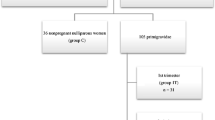Abstract
Introduction and hypothesis
We compared the maximal voluntary contraction (MVC) and strength of pelvic floor muscles (PFM) of pregnant and nonpregnant women using surface electromyography (SEMG).
Methods
Fifteen pregnant primiparous women and 15 nulliparous nonpregnant women were evaluated. The healthy pregnant women were in the third trimester of pregnancy with a single fetus and did not have any neuromuscular alterations. The nonpregnant women did not present with PF dysfunctions and, as with the pregnant women, did not have any previous gynecological surgeries or degenerative neuromuscular alterations. The evaluation methods used were digital palpation (Oxford Grading Scale, which ranges from 0 to 5) and SEMG. In the EMG exam, MVC activity was evaluated, and the better of two contractions was chosen. Before the evaluation, all women received information about PFM localization and function and how to correctly contract PFM.
Results
In the EMG evaluation, MVC was significantly greater in the nonpregnant group (90.7 μv) than in the pregnant group (30 μv), with p < 0.001. The same results were observed after vaginal palpation, measured by the Oxford scale, which presented an average of 2.1 in the pregnant group and 4.5 in the nonpregnant group (p = 0.005).
Conclusion
In comparison to nulliparous women, pregnant women demonstrated worse PFM function with decreased strength and electrical activity.
Similar content being viewed by others
References
Madill S, Harvey MA, McLean L (2010) Women with stress urinary incontinence demonstrate motor control differences during coughing. JEK 20:804–812
Gregory WT, Nygaard I (2004) Childbirth and pelvic floor disorders. Clin Obstet Gynecol 47(2):394–403
Wesnes SL, Hunskaar S, Bo K, Rorveit G (2009) The effect of urinary incontinence status during pregnancy and delivery mode on incontinence postpartum. A cohort study. BJOG 116(5):700–707
DeLancey JOL, Kearney R, Chou Q, Speights S, Binno S (2003) The appearance of levator ani muscle abnormalities in magnetic resonance images after vaginal delivery. Obstet Gynecol 1(1):46–53
Oliveira C, Lopes MAB, Pereira LCL, Zugaib M (2007) Effects of pelvic floor muscle training during pregnancy. Clinics 62(4):439–446
Botelho S, Ricetto C, Herrmann V, Pereira LC, Amorim C, Palma P (2010) Impact of delivery mode on electromyographic activity of the pelvic floor:comparative, prospective study. Neurourol Urodyn 29(7):1258–1261
Viktrup L (2002) The risk of lower urinary tract symptoms five years after the first delivery. Neurorurol Urodyn 21(1):2–29
Viktrup L, Rortveit G, Lose G (2008) Does the impact of subsequent incontinence risk factors depend on continence status during the first pregnancy or the postpartum period 12 years before? A cohort study in 232 primiparous women. Am J Obstet Gynecol 199(73):e1–e4
Grape HH, Dedering A, Jonasson AF (2009) Retest reliability of surface electromyography on the pelvic floor muscles. Neurourol Urodyn 28(5):395–399
Stüpp L, Resende APM, Petricelli C, Nakamura MU, Alexandre SM, Zanetti MD. (2011) Pelvic floor muscle and transversus abdominis activation in abdominal hypopressive technique through surface electromyography. Neurourol Urodyn, erly view
Resende APM, Zanetti MRD, Petricelli CD, Castro RA, Alexandre SM, Nakamura UM (2011) Effects of the Paula Method in electromyographic activation of the pelvic floor: a comparative study. Int Urogynecol J 22:677–680
Enck P, Vodusek DB (2006) Electromyography of pelvic floor muscles. JEK 16(6):568–577
Wall LL (1993) The muscles of the pelvic floor. Clin Obstet Gynecol 36(4):910–925
Morkved S, Salvesen KA, Bo K et al (2002) Pelvic floor muscle strenght and tickness in continent and incontinet nulliparous pregnant women. Int Urogynecol J Pelvic Floor Dysfunct 15:384–390
Sampselle CM, DeLancey JOL, Ashton-Miller J (1996) Urinary incontinence in pregnancy and postpartum. Neurourol Urodyn 15:329–330
Allen RE, Warell DW (1987) The role of pregnancy and childbirth in partial denervation of the pelvic floor. Neurourol Urodyn 6:183–184
Atalah SE, Castillo LC, Castro SR, Áldea PA (1997) Propuesta de un nuevo estandar de evaluación nutricional em embarazadas. Rev Med Chile 125:1429–1439
Bo K, Sherburn M (2005) Evaluation of female pelvic floor muscle function and strength. Phys Ther 85(3):269–282
Hove MCPS, Goudzwaard ALP, Eijkemans MJC, Theunissen RPMS, Burger CW, Vierhout ME (2009) Face Validity and Reliability of the First Digital Assessment Scheme of Pelvic Floor Muscle Function Conform the New Standardized Terminology of the International Continence Society. Neurourol Urodyn 28:295–300
Moen MD, Noone MB, Vassallo BJ, Elser DM (2009) Pelvic floor muscle function in women presenting with pelvic floor disorders. Int Urogynecol J 20:843–846
Petrus PE, Ulmsten U (1999) An Anatomical Classification – A new paradigm for management of urinary dysfunction in the female. Int Urogynecol J 10:29–35
Wester C, Brubaker L (1998) Normal pelvic floor physiology. Obstet Gynecol Clin North Am 25(4):707–722
Fast A, Weiss L, Ducommun E et al (1990) Low-back pain in pregnancy. Spine 15:28–30
Gilleard WL, Brown JMM (1996) Structure and function of the abdominal muscles in primigravid subjects during pregnancy and the immediate posbirth period. Phys Ther 76(7):750–762
Sapsford RR, Hodges PW (2001) Contraction of the pelvic floor muscles during abdominal maneuvers. Arch Phys Med Rehabil 82:1081–1088
Fritsch H (2006) Anatomy and Physiology of the pelvic floor. In: Carrière B, Feldt CM. The Pelvic Floor. Thieme, pg 1–21
Conflicts of interest
None.
Author information
Authors and Affiliations
Corresponding author
Rights and permissions
About this article
Cite this article
Resende, A.P.M., Petricelli, C.D., Bernardes, B.T. et al. Electromyographic evaluation of pelvic floor muscles in pregnant and nonpregnant women. Int Urogynecol J 23, 1041–1045 (2012). https://doi.org/10.1007/s00192-012-1702-6
Received:
Accepted:
Published:
Issue Date:
DOI: https://doi.org/10.1007/s00192-012-1702-6




